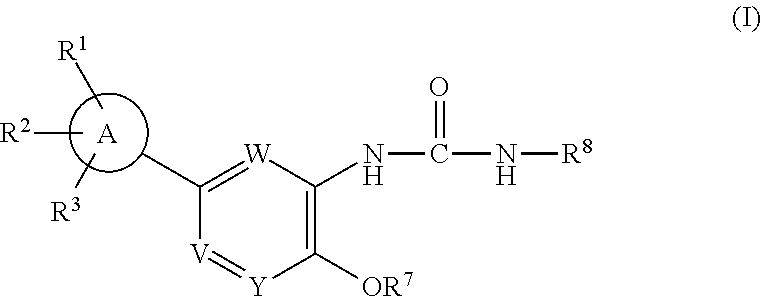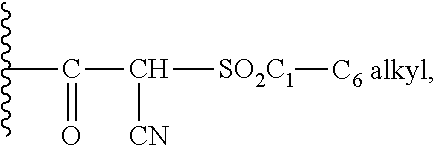IDO inhibitors
- Summary
- Abstract
- Description
- Claims
- Application Information
AI Technical Summary
Benefits of technology
Problems solved by technology
Method used
Image
Examples
example 1
4′-(2-tert-Butylphenoxy)-4-chloro-3′-(3-p-tolylureido)biphenyl-3-carboxylic acid
[0218]
1A. 4-Bromo-1-(2-tert-butylphenoxy)-2-nitrobenzene
[0219]
[0220]To a stirred solution of 4-bromo-1-fluoro-2-nitrobenzene (4.40 g, 20 mmol) and 2-tert-butylphenol (3.06 g, 20.40 mmol) in DMF (Volume: 20 mL) was added potassium carbonate (5.53 g, 40.0 mmol). The mixture was heated to 100° C. and stirred for 4 h. The reaction was cooled, diluted with water, and extracted with 1:1 EtOAc-hexanes. The organic extract was dried and stripped to afford 6.9 g (99%) of 4-bromo-1-(2-tert-butylphenoxy)-2-nitrobenzene (1A) as an oil which solidified on the pump to give large crystals with a bit of residual oil. mp. 59-61° C. HPLC Tr: 15.4 min.b 1H NMR (400 MHz, DMSO-d6) δ ppm 8.29 (d, 1H, J=2.4 Hz); 7.81 (dd, 1H, J=8.9, 2.3 Hz); 7.46 (dd, 1H, J=7.8, 1.9 Hz); 7.18-7.47 (m, 2H); 6.94 (dd, 1H, J=8.1, 1.6 Hz); 6.89 (d, 1H, J=8.9 Hz); 1.33 (s, 9H).
1B. 5-Bromo-2-(2-tert-butylphenoxy)aniline
[0221]
[0222]To a stirred solut...
example 2
4′-(2-tert-Butylphenoxy)-3′-(3-p-tolylureido)biphenyl-2-carboxylic acid
[0228]
2A. 3′-Amino-4′-(2-tert-butylphenoxy)biphenyl-2-carboxylic acid
[0229]
[0230]A suspension of 5-bromo-2-(2-tert-butylphenoxy)aniline (1B) (0.5 g, 1.561 mmol) and 2-boronobenzoic acid (0.389 g, 2.342 mmol) and tetrakis(triphenylphosphine)palladium (0) (0.054 g, 0.047 mmol) in degassed DMF (Volume: 8 mL) was treated with aq. potassium carbonate (4.16 mL, 6.25 mmol). The mixture was placed under nitrogen and heated to 100° C. for 2 h. The reaction was cooled, brought to pH 3 with aq. HCl, and extracted twice with dichloromethane. The combined organic extract was dried, stripped, and chromatographed on silica gel (gradient elution with EtOAc-hexanes-1% HOAc) to afford 0.41 g (69%) of 3′-amino-4′-(2-tert-butylphenoxy)biphenyl-2-carboxylic acid (2A) as a yellow glass. 1H NMR (400 MHz, DMSO-d6) δ ppm 7.63 (dd, 1H, J=7.7, 1.3 Hz); 7.52 (dd, 1H, J=7.6, 1.5 Hz); 7.33-7.43 (m, 3H); 7.13-7.19 (m, 1H); 6.99-7.04 (m, 1H); 6...
example 3
5-(5-(3-(2-Chlorophenyl)ureido)-4-methyl-6-(5,6,7,8-tetrahydronaphthalen-1-yloxy)pyridin-3-yl)-2-methoxybenzoic acid
[0234]
3A. 5-Bromo-4-methyl-3-nitro-2-(5,6,7,8-tetrahydronaphthalene-1-yloxy)pyridine
[0235]
[0236]To a solution of 5,6,7,8-tetrahydronaphthalen-1-ol (0.148 g, 1.000 mmol) and 5-bromo-2-chloro-4-methyl-3-nitropyridine (0.251 g, 1 mmol) in DMF (Volume: 4 mL) was added potassium carbonate (0.276 g, 2.000 mmol). The mixture was warmed to 100° C. for 4 h then cooled and diluted with water. This dark suspension was extracted twice with dichloromethane, and the combined organic extract dried and stripped to afford a dark oil. Chromatography on silica gel (gradient elution with ether-hexanes) afforded 0.2 g (50%) of 5-bromo-4-methyl-3-nitro-2-(5,6,7,8-tetrahydronaphthalen-1-yloxy)pyridine (3A) as an oily solid. 1H NMR (400 MHz, DMSO-d6) δ ppm 8.46 (s, 1H); 7.15 (t, 1H, J=7.7 Hz); 7.01 (d, 1H, J=7.5 Hz); 6.93 (d, 1H, J=7.5 Hz); 2.72-2.77 (m, 2H); 2.37-2.42 (m, 5H); 1.63-1.71 (m, ...
PUM
 Login to view more
Login to view more Abstract
Description
Claims
Application Information
 Login to view more
Login to view more - R&D Engineer
- R&D Manager
- IP Professional
- Industry Leading Data Capabilities
- Powerful AI technology
- Patent DNA Extraction
Browse by: Latest US Patents, China's latest patents, Technical Efficacy Thesaurus, Application Domain, Technology Topic.
© 2024 PatSnap. All rights reserved.Legal|Privacy policy|Modern Slavery Act Transparency Statement|Sitemap



